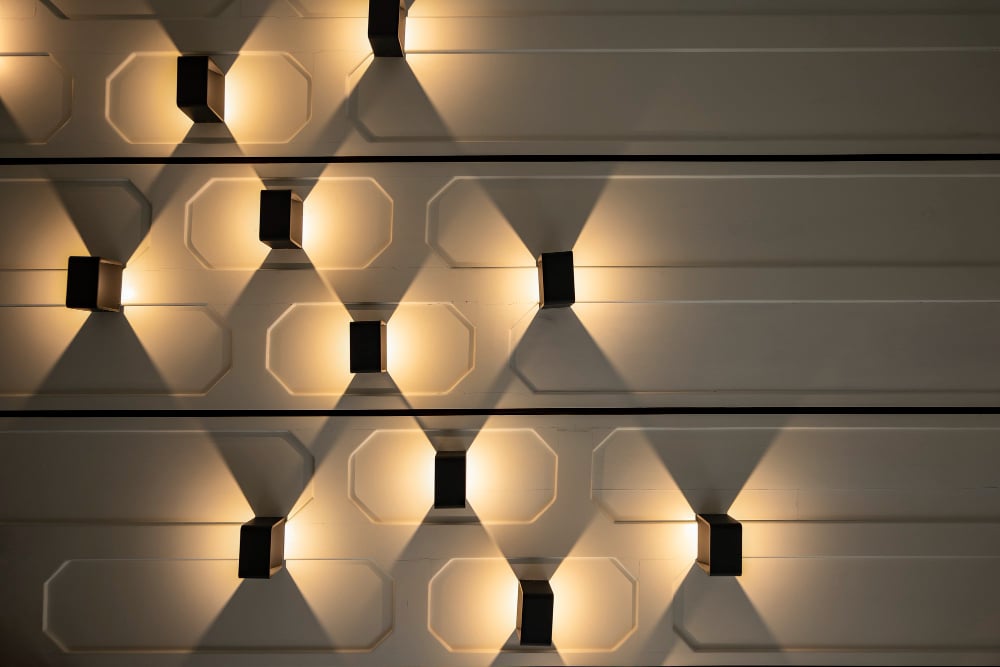Lighting is an essential aspect of interior design that can transform a space from ordinary to extraordinary. As technology continues to evolve, so does the world of lighting design. From energy-efficient LED lights to interactive lighting systems, lighting design concepts are changing the way we experience light in our homes and businesses.
Table of Contents
The Role of Light in Design
In visual environment design, light is essential, as it allows for work and movement by making architecture, people, and objects visible. The role of lighting design concepts in how we perceive and respond to our surroundings cannot be overstated, affecting both our feelings and reactions.
Understanding LUX, Lumens, and Other Lighting Terms
Luminous Intensity
Luminous intensity is an important measurement when it comes to visible light in a specific direction per solid angle. It is measured in candela (cd), which is the standard unit of measurement.
Luminous Flux
Luminous flux is another important measurement that measures the output of visible light from a light source, such as a lamp. Its standard unit of measurement is the lumen (lm). It is important to note that the luminous flux of a light source can vary depending on the direction the light is emitted.
Lux and Illuminance
Lux is the standard unit for measuring illuminance and luminous emittance. It measures the luminous flux per unit area. One lux is equal to one lumen per square meter. It is important to note that the illuminance level required in a typical home can vary depending on the size of the room and the intended use of the room. For example, a kitchen may require a higher illuminance level than a bedroom.
Power
Power refers to the electrical energy required by the lamps in the context of lighting. It is typically measured in watts (W). It is important to note that the power requirement of a lamp can vary depending on the type of lamp and the intended use of the lamp. For example, a lamp used for reading may require a higher power output than a lamp used for mood lighting.
Considerations for Your Lighting Design Scheme
Lighting design goes beyond determining the correct lux level and lighting intensities; it caters to both the physiological visual requirements and emotional needs of users. Three main types of environments necessitate different lighting design approaches:
- Work environments and public places prioritize functionality, safety, and communication.
- Exhibition and sale environments focus on the exhibit and the user’s viewing experience.
- Residential or touristic environments aim to create an atmosphere of comfort and relaxation.
In each of these, one must consider function, behavioural effects, aesthetics, budget, light and shadow play, direct and indirect light, light colour, task lighting, ambient lighting, and light control.
Emphasizing Functionality in Design
Determining the function of a space is essential, as it guides decisions regarding glare, visual comfort, and task illumination. Current regulations and standards provide specific lighting requirements for different tasks. It’s also crucial to understand the activities that will take place, their frequency, and the time of day they will occur.
Influence of Lighting on Behaviour
Lighting plays a critical role in shaping the way people behave, and it is essential to consider its potential impact on users when designing. While lighting can have a positive impact on health and behaviour, it can also have negative effects if not used correctly. For instance, bright lighting can be stimulating and help people stay focused, but harsh or flickering lights can cause headaches and eye strain.
Aesthetics and Budget
Our perception of space can be profoundly influenced by lighting. A well-executed architectural design can be rendered dull with poor lighting design concepts, while clever lighting design can improve an otherwise unimpressive space. Also, keeping the project within budget is a must, often requiring creative solutions to achieve desired effects without overspending.
Light and Shadow
A successful lighting design creates texture and depth by designing varying levels of light, producing soft shadows that draw attention to lit areas. This can be used to emphasize a room’s main features. To create the illusion of a larger room, illuminate the walls with the brightest light to make the entire room visible and reflect more light into the space.
Understanding Direct and Indirect Light
Direct light shines directly from a lamp into a room, providing bright and more focused illumination, but it can also cause glare. Indirect light reflects off a surface, diffusing across it to provide a relaxed atmosphere with less eye strain. To avoid blandness, a combination of light and shadow can be used to offer visual interest.
Choosing the Right Colour of Light
The colour of light can have a significant impact on the overall atmosphere of a room. By selecting the right colour, you can create a space that is perfectly suited to your needs. For example, cold colours that contain bluer can create a stimulating and energetic environment, which is perfect for workspaces or areas where you need to be alert and focused. On the other hand, warm colours with more red can generate a relaxing, comfortable environment, which is ideal for areas such as living rooms and bedrooms.
Task Lighting
Task lighting is an essential part of any lighting design concept. It provides additional light for specific tasks in a room where ambient lighting won’t suffice, such as reading or cooking. To ensure that task lighting is effective, it should be free of distracting glare and shadows. Additionally, it should be bright enough to prevent eye strain, but not so bright that it causes discomfort.
Ambient Lighting
Ambient lighting is another critical component of any lighting design. It provides a room with overall illumination, creating a comfortable level of brightness without glare. This type of lighting is essential for ensuring that you can see and walk about safely in a room. There are many different types of fixtures that can be used to achieve ambient lighting, including chandeliers, ceiling or wall-mounted fixtures, recessed or track lights, and even table and floor lamps.
Light Control
Controlling the light in a room is an often-overlooked aspect of lighting design, but it can make a significant difference in the overall atmosphere of your space. There are many different ways to control the light in a room, from adjusting the intensity with dimmers to changing the direction of the light source. By having more control over your lighting, you can adjust the ambience of your space to suit different moods or times of the day. For example, you might want to create a more relaxing atmosphere in the evening or a more energizing environment during the day.
Frequently Asked Questions about Lighting Design Concepts
What is lighting design?
Lighting design is the process of planning and implementing the lighting of a space in order to achieve a particular aesthetic or functional goal. It involves considering the purpose of the space, the activities that will take place in the space, and the desired mood or atmosphere.
Why is lighting design important?
Lighting design is important because it can have a significant impact on the look and feel of a space. Proper lighting can enhance the functionality of a space, improve safety and security, and create a mood or atmosphere that supports the intended use of the space.
What are some common types of lighting fixtures used in lighting design?
Some common types of lighting fixtures used in lighting design include recessed lights, pendant lights, track lighting, chandeliers, and wall sconces.
What is the difference between ambient, task, and accent lighting?
Ambient lighting provides overall illumination for a space, while task lighting is focused on a specific area or task, such as reading or cooking. Accent lighting is used to highlight a particular feature or object in a space.
How do I determine the appropriate lighting levels for a space?
The appropriate lighting levels for a space depend on the intended use of the space. For example, a workspace may require brighter lighting than a living room. Lighting designers use a variety of tools and techniques to determine appropriate lighting levels, including light meters and calculations based on square footage and wattage.
What is colour temperature and how does it affect lighting design?
Colour temperature refers to the perceived warmth or coolness of a light source, measured in degrees Kelvin. Warmer colour temperatures (lower Kelvin values) tend to create a cosy, inviting atmosphere, while cooler colour temperatures (higher Kelvin values) can create a more energizing or clinical atmosphere. Lighting designers consider colour temperature when selecting light sources in order to achieve the desired mood or atmosphere.
Conclusion
Lighting design is an ever-evolving field that has the power to transform a space and enhance our well-being. From energy-efficient lighting options to unique lighting fixtures and creative use of lighting in interior design, there are countless possibilities for creating beautiful and functional spaces. As technology continues to evolve, we can expect to see more innovative lighting design concepts that push the boundaries of creativity and functionality. Whether it is for homes, businesses, or public spaces, lighting design will continue to play a crucial role in creating spaces that are comfortable, inviting, and inspiring.
Elevate Your Lighting Design with Neoalpha Global
At Neoalpha Global, we are a team of experienced lighting designers who specialize in providing high-quality lighting design services to architects, property developers, and project managers. Our team has a deep understanding of the latest software solutions and industry trends, and we are committed to bringing your vision to life. Whether you need assistance with designing lighting schemes for residential and commercial buildings, theatrical performances, or public installations, we have the expertise and creativity to elevate your projects to new heights. Contact us today to learn more about our services and how we can help you shine!








